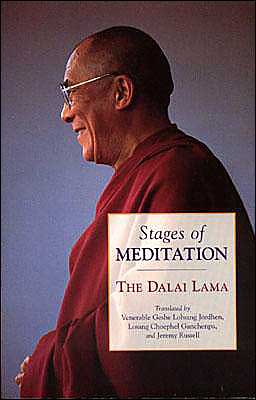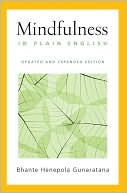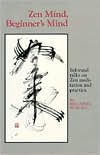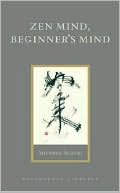Stages of Meditation
The Dalai Lama explains the principles of meditation in a practice-oriented format especially suited to Westerners. Based upon the middle section of the Bhavanakrama by Kamalashila, a translation of which is included, this is the most extensive commentary given by the Dalai Lama on this concise but important meditation handbook. It is a favorite text of the Dalai Lama, and he often takes the opportunity to give teachings on it to audiences throughout the world. In his words, "This text can be...
Search in google:
The Dalai Lama explains the principles of meditation in a prectice-oriented format especially suited to Westerners. Library Journal The Dalai Lama has scarcely been silent or inaccessible; he is without a doubt the best-known representative of not only the plight of his country of Tibet under the hard rule of Communist China but of the practices of Tibetan Buddhism itself. is This brief work, aimed especially at the Western reader, expounds, in the master's typically unruffled style, how to recognize the nature of suffering and how to achieve wisdom and "calm abiding." While this is not the easiest or clearest introduction to Buddhist practice, any work from the hand of the Dalai Lama will arouse intense interest in Buddhist and non-Buddhist readers alike. Copyright 2000 Cahners Business Information.
\ \ \ \ \ Chapter One\ \ \ What Is the Mind?\ \ \ It is not possible for omniscience to be produced without causes, because if it were everything could always be omniscient. If things were produced without reliance on something else, they could exist without constraint—there would be no reason why everything could not be omniscient. Therefore, since all functional things arise only occasionally, they depend strictly on their causes. Omniscience too is rare because it does not occur at all times and in all places, and everything cannot become omniscient. Therefore, it definitely depends on causes and conditions.\ \ \ According to this text, there are two types of existent phenomena: those that exist permanently and those that exist at some times but not at others. What is the implication of this second kind—existing at times but not existing at others? Such a question naturally arises. The implication is that temporary things depend on causes. The fact that certain things are produced at certain times proves the existence of causes. To say that certain things are produced at some times but not at others indicates that they are not independently produced, but rather that they depend on other conditions. Therefore, all those phenomena that are produced at some times but not others depend on causes and conditions, and they are of various types. Causes are of different types, such as substantial cause, direct cause, indirect cause, cause of equal state, concomitant cause, and so forth. Similarly, there are various types of conditions, like objective condition, causalcondition, immediate condition, and so forth. So those phenomena that depend on causes and conditions change by nature; they do not abide in one place and they are not permanent.\ Conditioned phenomena in turn can be classed under three categories—form, consciousness, and neither of the two. Form consists of such aspects as shape, color, and so forth, which can be seen by the eyes and touched by the hands. Consciousness has neither shape nor color and cannot be measured in any physical terms, but it exists in its nature and ability to feel and sense. Time, on the other hand, has neither form nor consciousness and belongs to the third category.\ Omniscient transcendental wisdom refers to the consciousness that knows everything. Omniscience is not a quality found in soil, stones, rocks, or mountains. It is produced by something whose function is awareness of objects, and therefore it cannot be produced by anything that lacks the property of awareness. Of course, the state of omniscience is the ultimate goal encompassing every perfection, and of the three categories of conditioned phenomena it belongs to the category of consciousness.\ Knowing or understanding is the function of consciousness. For example, when we say, "I understand" or "I see," and we have an experience or feeling about something, the experience is activated by consciousness. When the eye consciousness sees a physical form, we say, "I see the physical form," and when the mind consciousness experiences happiness or pain, we say, "I am happy," or "I am in pain." Thus, when we say, "I experience," "I see," or "I hear," and so forth, it is consciousness that acts as the agent. That which possesses the function of knowing is consciousness.\ Consciousnesses vary in the scope of their knowledge and in their intensity or sharpness. An obvious example is the consciousness of a human being, compared to an animal's consciousness. The human being's perception is much broader and it understands a much greater variety of objects. The consciousnesses of human beings vary with education and experience—the more educated you are and the more experience you have, the broader your consciousness. Knowledge and understanding develop on the basis of a consciousness that has the ability to perceive its objects. When the necessary conditions are met, its ability to perceive increases, the scope of its objects of knowledge expands, and understanding deepens. In this way the mind can develop its full potential.\ Omniscience is the full consummation, or perfection, of the mind's ability to perceive objects. It is omniscient in the sense that it can know each and every thing without being obstructed by differences of time and space. All-knowing wisdom arises from consciousness and by definition it is produced by causes and conditions. This implies that even omniscient wisdom cannot come about without its causes. If this were not the case, and an omniscient mind could arise without causes, it would imply that every consciousness was omniscient. This is because if things are produced without causes and conditions, either they must exist at all times or they must be completely non-existent. "If things were produced without reliance on other things, they would not be liable to be obstructed at any place." This is to say that if things were produced without depending on other causes and conditions, there is no logical reason why they should be obstructed at any point. Since this is not the case, it is logical that everything cannot be transformed into omniscience. For these reasons, functional phenomena can be produced at certain times and are not produced at other times. At a certain point in time, when favorable conditions come about and adverse conditions are absent, a consciousness can be transformed into omniscience that has the knowledge of all phenomena.\ Since things are not produced at all times and in all places, the implication is that they depend on causes and conditions. Within the framework of dependence on causes and conditions, those who aspire to the final fruit of omniscience should generate the causes and conditions—the complete and correct causes and conditions. Besides this, aspirants must be highly motivated in their pursuit. Therefore, it is taught that omniscience depends on causes and conditions.\ As explained in Asanga's Compendium of Knowledge with reference to effects being generated by their causes and conditions, the conditions are the unwavering condition, the impermanent condition, and the potential condition. What has been said earlier concerns the impermanent condition. When we ask how omniscience can be generated out of consciousness, we are talking about its potential condition. The ability to be aware of objects is an innate quality of consciousness. The very nature of consciousness is that it is clear and aware. It arises in the aspect of the object it apprehends. This attribute of awareness is not something newly created by other factors.\ Now the question is how that awareness can grow and expand to a limitless scope. The ability to be aware of its objects is innate to consciousness, but there are things that impede the mind from opening up to the state of complete knowledge. The next question is how those obstacles come about. We need to consider how such obstacles can be removed. What obstructs consciousness from being aware of its object is the ignorance that is a misconception of true existence, also referred to as the ignorance holding to one extreme, the extreme of reification.\ When we speak of ignorance, what we mean is that the consciousness either lacks some favorable condition, or some adverse condition is obstructing it from being aware of its object. Of the many types of ignorance, ignorance that is a misconception of true existence is the root, the power holder, so to speak. And this ignorance is the chief obstacle. We need to come to the conclusion through analysis that this ignorance is something that can be removed and eliminated. The defects of the mind arise primarily due to ignorance and its latent potential. We need to investigate and determine whether ignorance can be separated from the mind, and whether ignorance can come to an end. Ignorance in this context is not mere stupidity, but the ignorance that is a misconception of true existence. It is a mind that perversely or wrongly misconceives its object. Therefore, by cultivating an unmistaken understanding as its antidote we can eliminate it.\ Both the ignorance that is a misconception of true existence and its antidote depend on causes and conditions. They are alike in that they grow when in contact with favorable conditions and cease to exist when confronted by adverse factors. We may ask, what are the differences between the two? Since the ignorance that is a misconception of true existence is a mind that is wrong with respect to its object, it cannot develop limitlessly. This is because it does not have a valid support. This mind is wrong, or perverse, in the sense that the way it conceives the object is contrary to the actual way the object exists. The mind perceiving selflessness is an antidote, or opponent, to this and is not mistaken with respect to its object. That is to say, it is correct with respect to its object, which means that the way it perceives its object conforms to the way the object actually exists. Because it is not a wrong perception, it has a valid basis of support.\ It was earlier stated that the ignorance that is a misconception of true existence could be brought to an end. This is because the ignorant mind does not have the support of being a valid cognition. On the other hand, the mind that perceives the selfless nature of an object does have the support of being a valid cognition. The ways these two minds perceive objects are in direct contradiction. The mind that perceives the selfless nature of an object is a powerful antidote against that ignorant mind, and therefore the ignorant mind can be overcome. This is analogous to the way in which any aspect of human misery can be reduced when the appropriate measures are applied to counter it. It is in the nature of things that their potential is reduced when confronted by opposing factors.\ The mind that perceives reality is referred to as transcendental awareness and is a positive quality of the mind. It has the support of being a valid cognition. It is in the nature of the mind that when you habituate it with a positive quality it can be developed limitlessly. Unlike the mind, the positive qualities of the body do not have this quality of being able to expand to a limitless extent. This is due simply to the fact that the body is composed of gross elements, and attributes of such gross form do not have the potential to expand limitlessly.\ When we say that the ignorant mind is perverse or wrong, we are talking about the way it misconceives reality. Now the pertinent questions are: What is reality? How is this mind mistaken about reality? And in what way does the mind wrongly apprehend reality? Reality or emptiness of true existence is something that can be established logically. There are sound, or perfect, reasons to prove the emptiness of inherent existence, and we can gain conviction in these reasons. On the other hand, there is no logical way to prove true existence. True existence is what appears to an ordinary, untrained consciousness. But when it comes under logical scrutiny, true existence cannot be found. Even in our everyday life we often find contradictions between the way certain things appear and their actual mode of existence; that is, the way things actually exist is different from the way they appear to exist. This notion can be illustrated quite simply: in worldly affairs, we talk about somebody being let down or disillusioned. Disillusionment arises due to a discrepancy between the way a situation appears to be and the way it actually is.\ Let us examine our situation as human beings. Compared to animals, our minds are immensely more powerful. We have the ability to analyze whether there is a reality beyond the level of appearance, whereas animals only deal with what appears to them. This is very clear, just as different people have different mental capacities. When we closely examine them, many of the minds that are generally understood as valid cognizers are also mistaken in a deeper sense. The way phenomena really exist is other than what appears to such minds. We normally perceive reality or emptiness as existing differently from the way it actually exists. Our perception of impermanent things like mountain ranges and houses does not conform to their actual mode of existence. Some of these things have existed for many centuries, even thousands of years. And our minds perceive them in just that way—as lasting and permanent, impervious to momentary change. Yet when we examine these objects on an atomic level, they disintegrate every moment; they undergo momentary change. Science also describes a similar pattern of change. These objects appear solid, stable, and lasting, but in their true nature, they constantly change, not keeping still even for a moment.\ Enthronement\ The Recognition of the Reincarnate Masters of Tibet and the Himalayas\ \ \ By Jamgon Kongtrul Lodröb Tayé\ Translated by Ngawang Zangpo\ \ Snow Lion Publications\ Copyright © 1997 Hugh Leslie Thompson. All rights reserved.\
Preface7Prologue10Introduction171What Is the Mind?282Training the Mind363Compassion424Developing Equanimity, the Root of Loving-Kindness485Identifying the Nature of Suffering596Wisdom857Common Prerequisites for Meditating on Calm Abiding and Special Insight948The Practice of Calm Abiding1079Actualizing Special Insight12210Unifying Method and Wisdom140Glossary159Bibliography of Works Cited163Tibetan Text of Stages of Meditation167
\ Library JournalThe Dalai Lama has scarcely been silent or inaccessible; he is without a doubt the best-known representative of not only the plight of his country of Tibet under the hard rule of Communist China but of the practices of Tibetan Buddhism itself. is This brief work, aimed especially at the Western reader, expounds, in the master's typically unruffled style, how to recognize the nature of suffering and how to achieve wisdom and "calm abiding." While this is not the easiest or clearest introduction to Buddhist practice, any work from the hand of the Dalai Lama will arouse intense interest in Buddhist and non-Buddhist readers alike. Copyright 2000 Cahners Business Information.\ \








